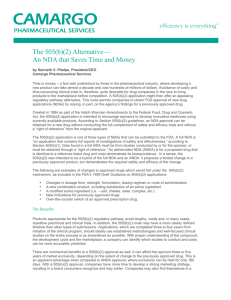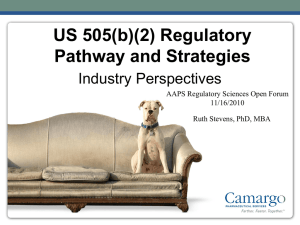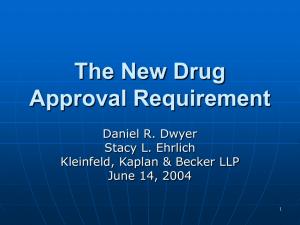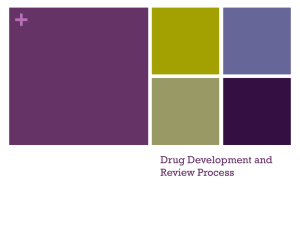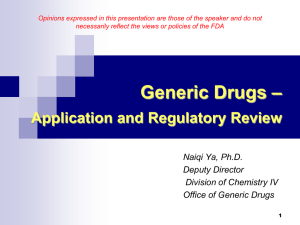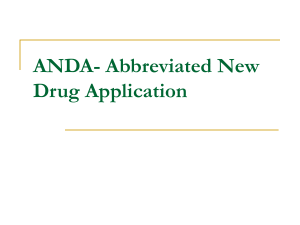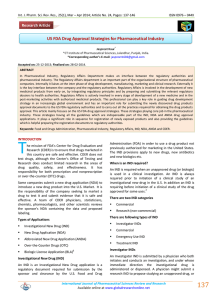The FDA’s 505(b)(2) Drug Approval Process And Implications For Managed Care Pharmacy
advertisement
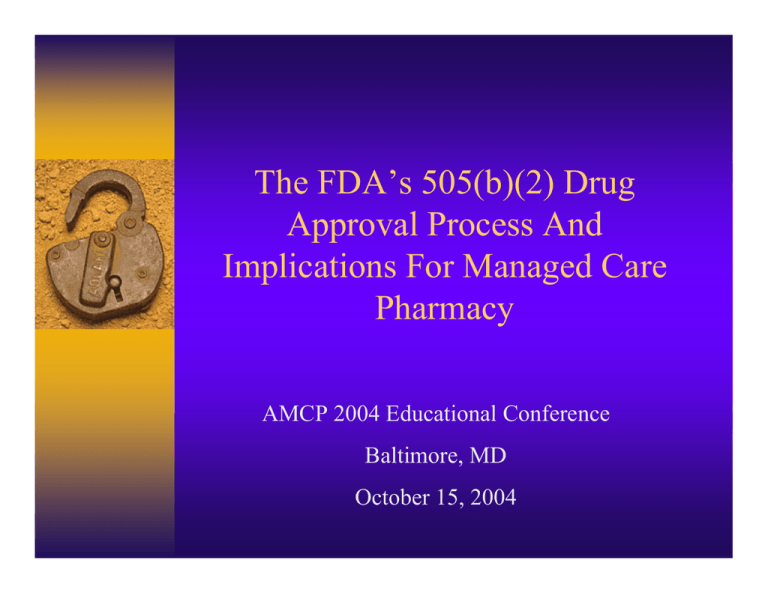
The FDA’s 505(b)(2) Drug Approval Process And Implications For Managed Care Pharmacy AMCP 2004 Educational Conference Baltimore, MD October 15, 2004 Paul J. O’Connor, RPh, MBA Aon Consulting Rebecca L. Dandeker, J.D. Kirkpatrick & Lockhart, LLP What Is a 505 (b)(2) Drug? ♦ Not a generic ♦ Not totally new ♦ Similar, but with limited differences, to previously approved drug ♦ Often an innovative variation of previously approved drug(s) containing the same active moiety Statutory Origins ♦ The Federal Food, Drug, And Cosmetic Act of 1938 – Proof of safety and manufacturing information Required for New Drugs – Copycat Drugs go directly to market – Not Required: • Proof of effectiveness • Affirmative FDA approval- Effective if no objection Kefauver-Harris Drug Amendments, 1962 ♦ Revision of NDA requirements – Proof of Effectiveness – Affirmative FDA approval – Retrospective review (DESI) for compliance to new standards of all NDA’s from previous 24 years – FDA’s published rulings on effectiveness applied to pioneer and copycat (me-too) drugs Kefauver-Harris (Con’t) ♦ Early version of ANDA – Only for products subject to a DESI notice – Submitted manufacturing data & labeling – Relied on safety & effectiveness (S&E) of pioneer ♦ Paper NDA – Approval of duplicate drug – Based solely on publicly available medical literature The Hatch-Waxman Amendments, 1984 ♦ Patent extension and market exclusivity for pioneer drugs ♦ Modern ANDA created – Based on Reference Listed Drug (RLD) – New Bioequivalence testing requirement – Manufacturing & labeling requirements continue Hatch-Waxman: 505(b)(2) Pathway ♦ 505(b)(1) - Traditional NDA for pioneer products ♦ 505(b)(2) - Streamlined approval process for new products with same active moiety as previously approved drug (RLD) Hatch-Waxman: 505(b)(2) Pathway – Requires full reports of investigations of S&E – But allows Sponsor to rely on “investigations” not conducted by the Sponsor and with no right of reference • Public scientific data from RLD • Published medical literature • Non-public data on file with FDA/Prior FDA S&E decision – Differences from RLD must be supported with Sponsor’s clinical data of safety and effectiveness Summary of Differences 505(b)(1) 505(b)(2) ANDA User Fees Yes Yes / No No Review Schedule 12 mo. 12 mo. 21 mo. Scientific Studies Full Partial Bioequiv alence New Active Moiety Yes No No New Chemical Entity (Ingredient) Yes Yes / No No New Indication Yes Yes No New Formulation Yes Yes Yes* New Dosage form or Strength Yes Yes No* Patented Yes Yes No Market Exclusivity Yes Yes No** * Limited changes ** Except against other generics Legal Controversy ♦ 2001 Pfizer Petition against FDA Policy ♦ 2002 Pfizer Petition against Dr. Reddy’s Labs’ (b)(2) NDA for amlodipine maleate tablets (RLD was besylate salt) ♦ 2003 Torpharm Petition against Synthon’s (b)(2) NDA for paroxetine mesylate tablets (RLD was hydrochloride salt) ♦ All denied by FDA, Oct. 14, 2003 Legal Arguments ♦ ♦ ♦ ♦ ♦ Opponents Codifies paper NDA policy Reference to NDA ‘investigations’ can be only published parts, not proprietary parts Undermines patent Inadequate Studies on (b)(2) drug Can’t support AB rating ♦ ♦ ♦ ♦ ♦ Proponents Step beyond paper NDA policy FDC Act expressly says ‘no right of reference’ and doesn’t say limit to ‘published’ Not permitted to infringe, must ‘design around’ Needless treatment with placebo avoided AB rating is appropriate if bioequivalent to RLD Legal Controversy Continues ♦ 2003 Bio Petition on subset of biologically- derived products – Pending – FDA says “unique scientific issues” ♦ 2004 Abbott Petition on differences in active ingredient only – Pending – Depakote (divalproex) vs. Andrx’ valproate sodium – FDA says these (b)(2) NDA’s may not offer a therapeutic benefit and may lead to marketplace confusion due to pharmaceutical alternatives Really, What Are 505(b)(2)’s? What Are The Practical Implications? How Does a 505 (b)(2) Differ From the Innovator Drug? ♦ Dosage form ♦ Strength ♦ Delivery mechanism ♦ Different formulation – (e.g., different salt, complex, enantiomer, new combination of previously approved drugs) Examples of 505(b)(2) Approvals ♦ New Delivery Mechanism – Canasa® (mesalamine) suppositories – Axcan – ClobexTM (clobetasol proprionate) lotion – Galderma – LuxiqTM (betamethasone valerate) foam - Connetics – TestimTM (testosterone) gel - Auxilium ♦ New Dosage Form – AltoprevTM (lovastatin) extended release tablets - Andrx – DepoDurTM (morphine Sulfate) liposomal injection – Skye Pharma – Doxil® (doxorubacin HCl) liposomal injection ♦ New Formulation – PexevaTM (paroxetine mesylate) tablets – Synthon – Stalevo® (carbidopa/levodopa/entacapone) tablets – Orion – Xopenex® (levabuterol HCl) inhalation – Sepracor ♦ New Indication – Avodart® (dutasteride) capsules - GlaxoSmithKline – Thalomid® (thalidomide) capsules - Celgene Sponsor’s Benefits of the 505 (b)(2) Pathway Vs. traditional NDA ♦ Simplified approval process – Use of previously published studies ♦ Quicker to market ♦ Lower cost ♦ Lower risk – “proven” commodity Benefits (Cont’d) Vs. ANDA (Generic) ♦ “Branded” generics to market sooner ♦ 505 (b)(2)’s may qualify for patent or additional marketing exclusivity – 3 to 5 years vs. 180 days for “first” ANDA – Length depends on amount of additional data required to support the application • 180 day exclusivity not available Practical Implications for Managed Care Pharmacy Formulary & Benefit Issues ♦ Likely simplified P&T review ♦ Pricing less than innovator – Possibly more expensive than generic ♦ Formulary positioning – Tier 1 or Tier 2? ♦ 505 (b)(2) may not be substitutable under state pharmacy law – Will the innovator drug be covered? Management Issues ♦ Timing – When will generic equivalents reach market? – Do you invest in an intervention to move market share that has only short-term value? – Alternatively, if 505 (b)(2) represents opportunity for significant savings, can you wait? Other Considerations ♦ Provider and/or patient education ♦ Need for pull-through – Unlike generic manufacturers, some assistance may be available from 505(b)(2) supplier ♦ Off-Label use for generics ♦ Potential for confusion Potential for Substitution ♦ Avita (tretinoin cream) – AB rated ♦ AmVaz (amlodipine maleate tablets) – not AB rated, but approved labeling says the bioavailability of amlodipine is not altered by salt form ♦ GA, LA, MI – pharmacist’s judgment ♦ CT, OR, TX – dosage form switch ♦ FL, IL, VA – state formulary Future ♦ Possible pathway for Biologic “generics” – FDA moving toward using 505(b)(2) as generic biologic pathway – But denied (b)(2) approval for Sandoz’ Omnitrope (DNA human growth hormone) • FDA: “Unable to reach a decision due to uncertainty regarding scientific and legal issues.” – Statutory changes needed? Future (cont’d) ♦ Most likely an increase in use of 505(b)(2) pathway – Medicare Modernization Act, 2003 limited the number of 30-Month Stays that can be granted by the FDA to innovator company • Reduced barrier to entry for 505(b)(2)’s • In practice, it increases window of opportunity to gain return on investment ♦ A more rigorous patenting of “similar” compounds by Pharmaceutical Manufacturers possible
